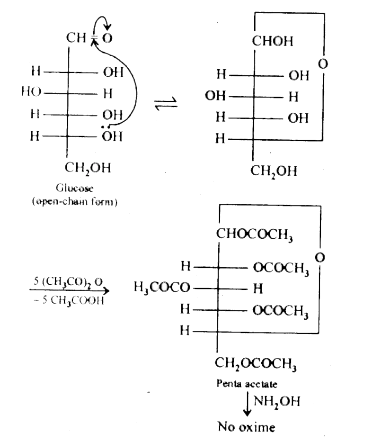How do you explain the absence of aldehyde group in the pentaacetate of D-glucose ?
Video Solution
Text Solution
The cyclic hemiacetal form of glucose contains an −OH group at C−1 which gets hydrolysed in aqueous solution of produce open chain aldehydic form which then reacts with NH2OH-to form corresponding oxime. Thus, glucose contains an aldehydic group. However, when glucose is reacted with acetic anhydride, the −OH group at C−l along with the other −OH groups of C−2,C−3,C−4 and C−6 form a pentaacetate.
Since the penta acetate of 1 glucose does not contain a free −OH group at C−1, it cannot get hydrolysed in aqueous solution to produce open chain aldehydic form and hence glucose pentaacetage does not react with NH2OH to form glucose oxime. The reactions are shown as

|
Updated on:21/07/2023
Topper's Solved these Questions
Similar Questions
How do you explain the presence of an aldehydic group in a glucose molecule ?
View SolutionHow do you explain the presence of an aldehydic group in a glucose molecule?
View SolutionHow do you explain the presence of an aldehydic group in a glucose molecule?
View SolutionHow do you celebrate?
View SolutionHow do you explain the presence of five-OH groups in glucose molecule ?
View SolutionHow do yout explain the presence of five −OH groups in glucose molecule?
View SolutionHow do yout explain the presence of five −OH groups in glucose molecule?
View SolutionHow do you explain the concept of sustainable development?
View SolutionHow do you explain the functionality of a monomer?
View SolutionHow do you explain the functionality of a monomer ?
View Solution

